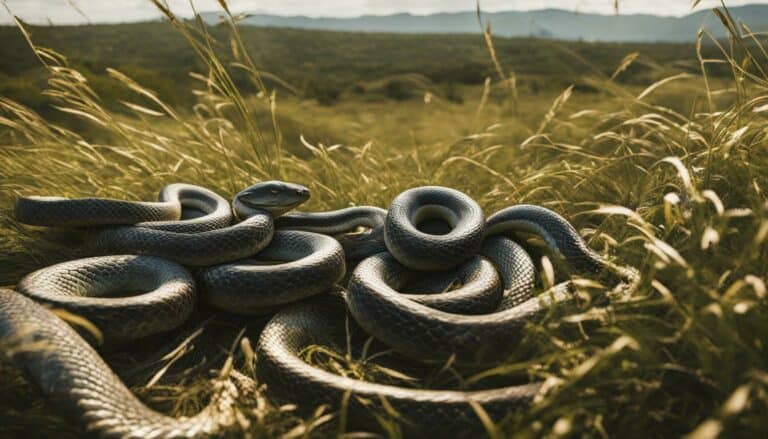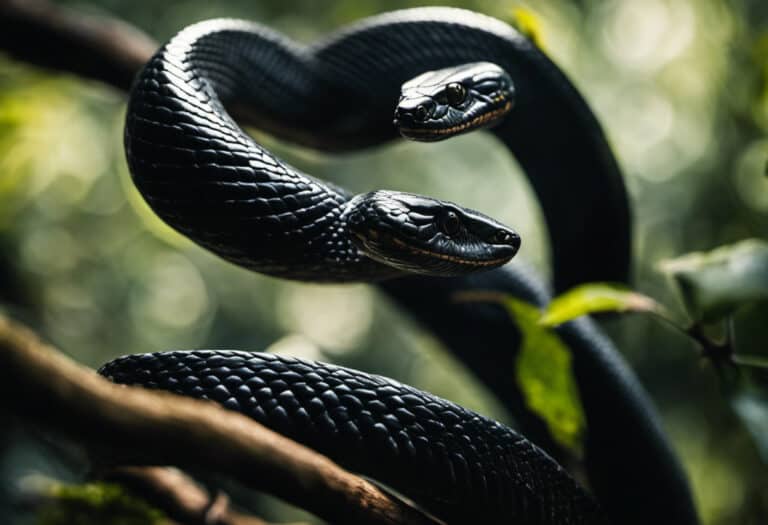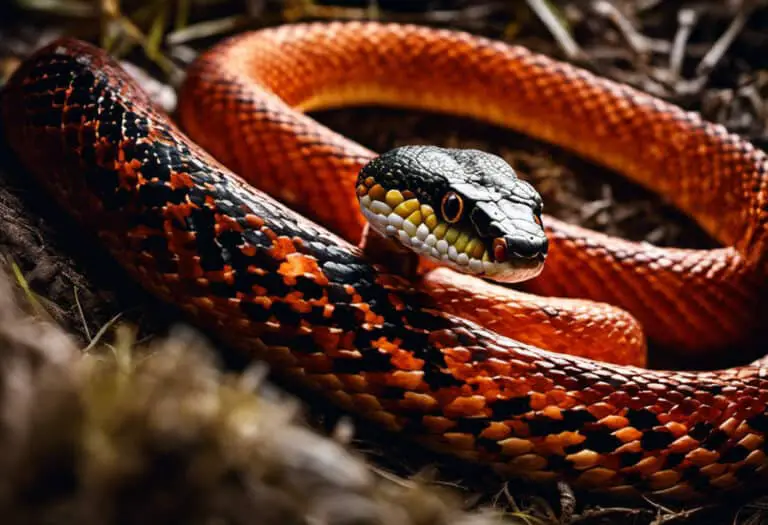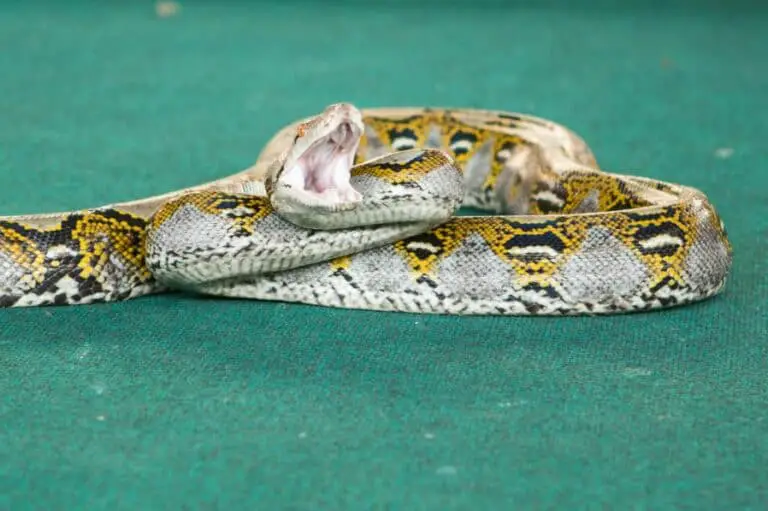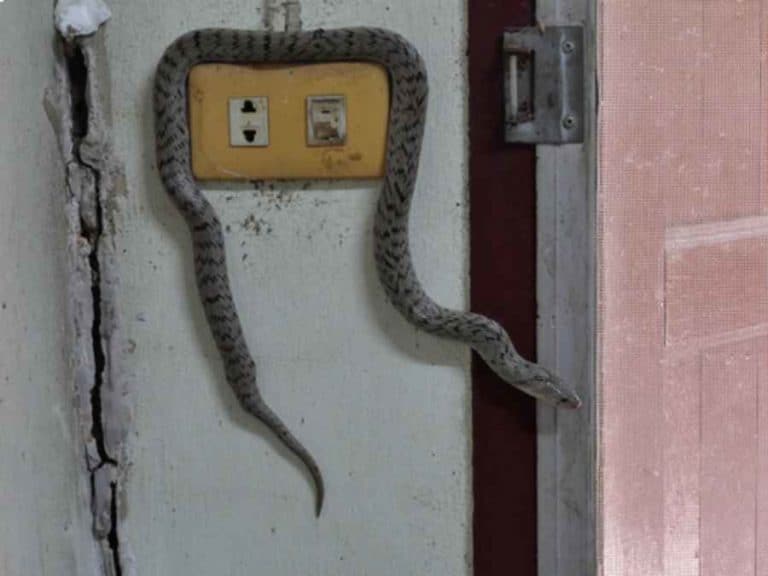How Do Snakes Move Around?
Do you ever marvel at the effortless way snakes navigate their surroundings? Prepare to be captivated as we delve into the mesmerizing world of snake locomotion.
Snakes possess a unique body structure and mobility that enables them to slither, climb, swim, and even fling themselves through the air. By unraveling their secrets, we can gain deeper insight into their behavior and survival strategies.
So, join us on this awe-inspiring journey and discover the remarkable abilities of these reptiles.
Key Takeaways
- Snakes have a long and strong body with a flexible spine and curved rib bones, allowing them to adapt to different terrains and environments.
- The most common mode of movement for snakes is lateral undulation, where they create an S-shaped pattern to push off irregularities in the ground and propel themselves forward.
- Snakes also use concertina movement, where they stretch out and anchor one section of their body to navigate through narrow spaces or obstacles.
- Sidewinding is a sideways movement used by snakes on hot or unstable ground, where they lift parts of their body off the ground and push to the right or left to maintain stability.
Snake Movement: An Overview
Snakes have different modes of travel, including lateral undulation, concertina movement, sidewinding, and linear progression. Each mode of movement allows snakes to efficiently navigate different environments.
Lateral undulation, which involves creating an S-shaped pattern, is the most common mode of movement. It allows snakes to push off irregularities in the ground, propelling them forward.
Concertina movement is used to navigate through narrow spaces or obstacles by stretching out and anchoring sections of their body.
Sidewinding is employed on hot or unstable ground, where snakes lift parts of their body while pushing to the right or left.
Linear progression, utilized by larger snakes and those living underground, is a straight-forward mode of travel using loose belly skin and muscles.
Snakes adapt their movement to ensure efficient locomotion in various environments.
Lateral Undulation: The Most Common Mode of Movement
Lateral undulation is the most common mode of movement for snakes. When snakes engage in lateral undulation, they create an S-shaped pattern to push off irregularities in the ground or landscape, resulting in forward propulsion.
This mode of movement allows snakes to adapt and navigate efficiently through various terrains and environments.
Efficiency of Lateral Undulation
When moving through uneven terrain, you may find that lateral undulation allows snakes to efficiently navigate by creating an S-shaped pattern for forward propulsion. This mode of movement is especially beneficial for snakes in extreme environments. Here’s why:
-
Efficient locomotion: Lateral undulation enables snakes to move smoothly and efficiently across various terrains, including rocky surfaces, dense vegetation, and steep slopes. By pushing off irregularities in the ground, snakes can generate forward momentum and cover long distances with minimal energy expenditure.
-
Adaptation to extreme environments: Snakes that inhabit extreme environments, such as deserts or sandy dunes, face unique challenges. Lateral undulation allows them to overcome these obstacles by effectively gripping and pushing against unstable surfaces, ensuring stability and preventing sinking or slipping.
-
Versatile movement strategy: Snakes can switch between different modes of travel based on the terrain they encounter. This flexibility allows them to adapt their movement patterns to maximize efficiency and ensure their survival in diverse and challenging environments.
Adaptability to Different Terrains
You can observe how snakes adapt to different terrains by studying their diverse modes of movement. One key adaptation is their ability to navigate desert environments. Snakes that inhabit deserts have developed specific strategies to move efficiently across the hot and sandy terrain.
One such strategy is the speed of lateral undulation. Lateral undulation is the most common mode of movement for snakes, where they create an S-shaped pattern to propel themselves forward.
In desert environments, snakes increase the speed of their lateral undulation to quickly traverse the sandy dunes. By moving rapidly in this manner, they can minimize their contact with the scorching hot ground and reduce the risk of overheating.
This adaptation allows snakes to thrive in the harsh conditions of desert environments, showcasing their remarkable ability to adapt to various terrains.
Concertina Movement: Navigating Narrow Spaces
In narrow spaces, snakes use concertina movement to navigate by stretching out and anchoring sections of their body. This unique mode of travel allows snakes to maneuver through tight spaces and obstacles with ease.
Here are three key aspects of concertina movement:
-
Anchoring: Snakes anchor the front or rear section of their body, while pulling up the other section. This creates an S-shaped pattern and allows the snake to move forward.
-
Stretching: By alternating between anchoring and stretching, snakes are able to extend their bodies and move through narrow spaces. This flexibility is crucial for their survival in confined areas.
-
Efficient navigation: Concertina movement enables snakes to traverse obstacles and squeeze through tight spaces, such as narrow crevices or burrows. It provides them with the freedom to explore their environment and find suitable hiding spots.
With concertina movement, snakes have the freedom to navigate even the most challenging and restricted spaces.
Sidewinding: Specially Adapted for Unstable Ground
Now let’s explore another fascinating way snakes move – sidewinding. Sidewinding is a specialized movement that allows snakes to navigate through unstable ground. Imagine yourself in a desert, where the sand is constantly shifting beneath your feet. To adapt to this challenging terrain, snakes have evolved this unique mode of travel.
When sidewinding, snakes lift parts of their body off the ground while pushing to the right or left. This movement leaves a distinctive series of squiggles in their wake. By minimizing the amount of contact with the ground, snakes reduce the risk of sinking or getting stuck. This is especially crucial for survival in areas with loose or shifting substrates.
Sidewinding also offers an advantage in terms of camouflage. The snake’s lateral displacement disrupts its body pattern, making it more difficult for predators or prey to detect them. This enhances their ability to blend into their surroundings, increasing their chances of a successful hunt.
Linear Progression: Straight-forward Travel for Larger Snakes
Linear progression, also known as rectilinear movement, is a mode of travel utilized by larger snakes and those living underground.
In this method, snakes use their loose belly skin and muscles to reach forward, while the body catches up simultaneously and quickly at multiple points along the body.
This results in a continuous and smooth motion, making linear progression an efficient and straightforward means of travel for these snakes.
Fastest Snake Movement
If you want to learn about the fastest snake movement, you’ll be interested to know that some snakes can slither at speeds of up to 12 miles per hour. This impressive speed is achieved through various evolutionary adaptations for speed.
- Streamlined Body Shape: Fast snakes have a slender and elongated body shape that reduces drag and allows for efficient movement through the environment.
- Muscular Power: These snakes have strong muscles that generate the force needed for quick propulsion.
- Flexible Spine: A flexible spine enables these snakes to undulate their bodies rapidly, pushing against the ground and propelling themselves forward.
These adaptations work together to allow these fastest snake species to move swiftly and efficiently, giving them an advantage in hunting and escaping from predators.
It’s fascinating to observe the incredible speed and agility of these remarkable creatures.
Efficiency of Linear Progression
You’ll notice that larger snakes and those living underground can travel efficiently in a straight line using a mode of travel called linear progression. This method allows them to move with great efficiency and speed.
Compared to other snake movement modes, such as lateral undulation or sidewinding, linear progression allows snakes to cover longer distances in a shorter amount of time.
The key to the efficiency of linear progression lies in the simultaneous and quick forward movement of multiple points along the snake’s body. By using the loose belly skin and powerful muscles, the snake can reach forward while the rest of its body catches up.
This continuous and smooth motion ensures that the snake can move swiftly and effectively through its environment.
Adaptation to Underground Habitats
When living underground, snakes have adapted to their habitat by developing specialized movement techniques. These adaptations allow them to efficiently navigate through the tight spaces and complex terrain found beneath the surface.
-
Burrowing adaptations: Snakes that live underground have unique features that aid in burrowing. These include a streamlined body shape, reduced eyesight, and powerful muscles that allow them to push through the soil.
-
Underground locomotion: Snakes use a combination of lateral undulation and concertina movement to move through underground environments. Lateral undulation is the most common mode of movement, where snakes create an S-shaped pattern to propel themselves forward. Concertina movement is used in tight spaces, where snakes stretch out and anchor one section of their body while pulling up the other to navigate obstacles.
These adaptations enable snakes to thrive in the underground world, demonstrating their remarkable ability to adapt to different environments.
Arboreal Movement: Climbing and Swinging Through Trees
Snakes use a combination of gripping scales and muscular contractions to navigate tree branches and move through the canopy. This type of movement is known as arboreal locomotion.
As a snake slithers through the trees, it uses its muscular contractions to propel itself forward and grip onto the branches. The gripping scales, also known as keeled scales, provide traction and prevent the snake from slipping.
Snakes have a flexible body that allows them to maneuver through the dense foliage of the canopy. They can coil their bodies around branches and even hang from them, using their strong muscles to support their weight.
Snakes are able to navigate the complex network of tree branches with ease, allowing them the freedom to explore their arboreal habitats.
Aquatic Movement: Swimming and Slithering in Water
As you enter the realm of aquatic movement, you’ll discover that snakes possess remarkable adaptations for swimming and slithering in water.
Their streamlined body shape allows them to glide effortlessly through the liquid medium, reducing drag and maximizing efficiency.
With an eel-like undulating motion, snakes propel themselves forward, utilizing their muscular bodies to generate propulsion and navigate the watery depths.
Streamlined Body Shape
You can observe that a snake’s streamlined body shape allows it to move efficiently through its environment. The snake’s long and slender body minimizes drag as it glides through the air or slithers across the ground. This streamlined shape reduces the amount of energy required for movement, allowing the snake to conserve its resources.
Additionally, the absence of limbs eliminates the need for complex joint movements, further enhancing energy efficiency. The snake’s body is perfectly adapted for its mode of locomotion, enabling it to navigate various terrains with ease. Whether it’s climbing trees, swimming through water, or burrowing underground, the snake’s streamlined body shape ensures optimal energy efficiency, allowing it to move freely and effortlessly.
Eel-Like Undulating Motion
Now, let’s dive into the fascinating topic of how snakes move around with their eel-like undulating motion.
This mode of locomotion, known as lateral undulation, is incredibly efficient for these slithering creatures. Snakes achieve this undulating movement by creating an S-shaped pattern with their body, allowing them to push off irregularities in the ground or landscape. As they contract and relax their muscles, this pattern propels them forward.
The efficiency of lateral undulation lies in the snake’s ability to maximize its forward propulsion while minimizing energy expenditure. By utilizing this undulating motion, snakes can adapt their speed and agility based on the terrain they encounter. However, it should be noted that lateral undulation is more challenging on featureless or unstable surfaces like sand dunes.
Snakes are truly masters of movement, effortlessly navigating their environment with their eel-like undulating motion.
Efficiency in Water Locomotion
You’ll be amazed at how efficiently snakes move through water using their eel-like undulating motion. This unique form of locomotion allows them to navigate through the aquatic environment with ease and grace.
- Snakes utilize their muscular bodies to create a series of waves that propels them forward in the water.
- Their undulating motion is similar to that of an eel, allowing them to smoothly glide through the water.
- This efficient mode of movement enables snakes to swim quickly and effectively, whether they’re hunting for prey or evading predators.
Not only are snakes adept swimmers, but they also exhibit remarkable adaptability in other terrains. In sandy environments, snakes employ a specialized mode of locomotion known as sidewinding. By lifting parts of their body off the ground and pushing to the side, snakes are able to navigate through the challenging sand dunes.
Additionally, snakes have the ability to adjust their movement in extreme temperatures, ensuring their survival in harsh environments. Their remarkable flexibility and adaptability make snakes truly fascinating creatures.
Burrowing Movement: Adaptations for Underground Travel
When moving underground, snakes have adaptations such as loose belly skin and muscles that allow them to navigate through tight spaces. These adaptations are crucial for their burrowing movement and enable them to efficiently travel underground.
Snakes have specialized muscles that help in digging and burrow construction. Their loose belly skin allows them to expand their body size, making it easier for them to squeeze through narrow tunnels. They also have strong muscles that provide the necessary power for digging through soil and creating burrows.
These adaptations enable snakes to maneuver through the underground environment, whether it’s a tunnel created by another animal or a self-made burrow. Their ability to navigate through tight spaces is essential for their survival and freedom of movement in their underground habitats.
Jumping and Gliding: Surprising Snake Mobility
You may not expect it, but snakes have the surprising ability to jump and glide through the air. This ability is the result of their unique jumping ability and gliding adaptations. Here’s how they do it:
- Snakes use their powerful muscles to launch themselves off the ground, propelling their bodies forward.
- They also have specialized scales on their undersides that can flatten out, creating a larger surface area for gliding.
- Some snake species have even developed flaps of skin along their bodies that act like wings, allowing them to catch the air and glide for longer distances.
These jumping and gliding adaptations give snakes the freedom to move through the air, expanding their range and allowing them to access new food sources and escape predators.
Mode of Travel Selection: Factors Influencing Snake Movement
Snakes adapt their movement based on factors such as terrain and size, allowing them to efficiently navigate their surroundings. Factors influencing snake movement include the type of terrain they encounter and their size.
Snakes use different modes of travel to maximize locomotion efficiency in different terrains. Lateral undulation, the most common mode of movement, involves creating an S-shaped pattern to push off irregularities in the ground or landscape.
Concertina movement is utilized when navigating through narrow spaces or obstacles, by stretching out and anchoring sections of their body.
Sidewinding is employed on hot or unstable ground, where snakes lift parts of their body off the ground while pushing to the right or left.
Additionally, larger snakes and those living underground use linear progression, a straight-forward mode of travel.
Frequently Asked Questions
What Are Some Unique Adaptations That Allow Snakes to Move Through Different Terrains?
Snakes have unique adaptations to move through different terrains. They use lateral undulation to push off irregularities on the ground and sidewinding to navigate unstable surfaces. These abilities allow snakes to efficiently travel in various environments.
How Do Snakes Navigate Through Narrow Spaces or Obstacles?
Snakes navigate narrow spaces or obstacles by utilizing their remarkable snake locomotion abilities. With their incredible body flexibility, they can employ concertina movement, stretching out and anchoring sections of their body to maneuver through confined areas.
What Factors Influence a Snake’s Choice of Movement Mode?
Factors influencing a snake’s choice of movement mode include environmental conditions and prey availability. Snakes adapt their movement based on the terrain, using lateral undulation, concertina movement, sidewinding, or linear progression to efficiently navigate their surroundings.
Can Snakes Jump or Glide?
Snakes, despite their incredible mobility, cannot jump like other animals. However, some snake species, like flying snakes, have the ability to glide through the air by flattening their bodies and using their scales to create lift.
Are There Any Specific Adaptations That Allow Snakes to Move in Water or Underground?
Snakes have specific adaptations for moving in water or underground. They can swim by using lateral undulation, while concertina movement helps them navigate narrow spaces. In deserts, sidewinding is used for stability, while larger snakes employ linear progression for underground travel.
Conclusion
In conclusion, the world of snake locomotion is truly remarkable. These reptiles have evolved a range of complex movement patterns to adapt to different terrains and environments.
From the graceful undulations of lateral movement to the agile sidewinding on unstable ground, snakes showcase their incredible flexibility and agility.
Their ability to navigate through water, burrow underground, and even glide through the air adds to their captivating repertoire of movements.
By understanding these intricate maneuvers, we gain a deeper appreciation for the fascinating abilities of these slithering creatures.
